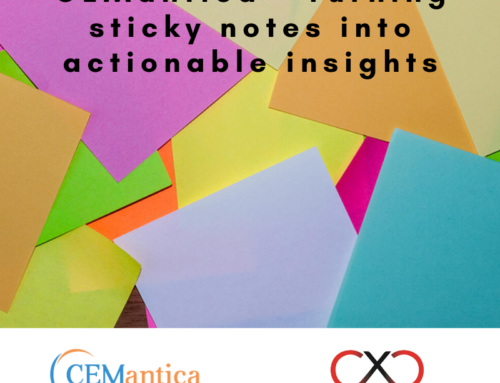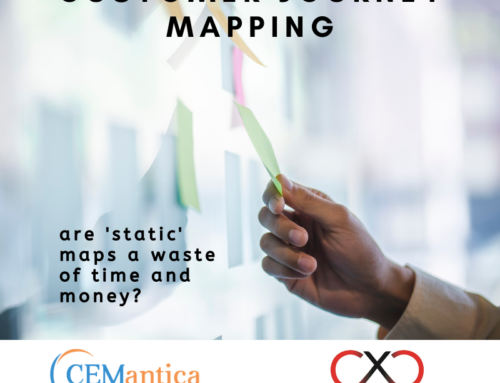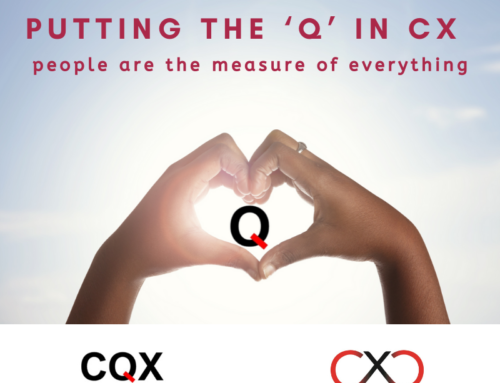
Before you start reading this post, I must make it clear that whilst the centrepiece of it is about a game, the real story is much, much more than that. This is a post about customer experience (CX) transformation – about the incredible work being done by a bank in Eastern Europe in their quest to become sustainably customer centric. It is a post that demonstrates how hard work, collaboration, resilience, innovation and fun, can combine to power the transformation journey.
I first met Laura Tengerdi and Andrea (Andi) Hanyecz in 2016. Budapest Bank had actually started its customer experience program at the end 2015. As head of marketing at the time, Laura worked hard to raise CX to become one of the organisations 5 strategic focuses. Laura and Andi suggest that I had something to do with this (as a result of their attendance at my CX Masterclass and the subsequent guidance I have given them on their CX journey), but it is completely down to their tenacity and the focus of their colleagues in multiple functions across the bank (product, quality, risk, HR, field sales from branches, telebank, digital channel among others) that they influenced it to happen.
The main objective was – by placing the CX mission in the centre of the banks thinking – to help customers to concentrate on and realise the most important things in their lives. The aim was to achieve this by putting the development of a genuine customer centric culture at the forefront of everything the bank did.
Since their vision was and still is, to build a loveable bank, it was an essential and inevitable step. They therefore named the approach to CX as the ’Butterfly Effect’ – they invited leaders and employees to join them by explaining the long term positive effects of CX.

The Butterfly Effect ‘Logo’
They also developed a program logo using the key elements of our bank’s emblem, which coincidentally, looks like a butterfly.
Today, their CX ‘programme’ is based on a structured framework – the CX Maturity Model. The model has 6 elements to it – elements that define the required competencies for Budapest Bank to become sustainably customer centric:
- strategy
- governance
- customer insight
- measurement
- customer journey management
- culture
So how does the framework reflect the ‘Butterfly Effect’? Why did Budapest Bank decide to use this as the name of their CX programme? The term ’butterfly effect’ comes from an analogy where a butterfly flaps its wings in Chicago and a tornado occurs in Tokyo. Small changes can make much bigger changes happen, it can have a big impact on the future. With their approach to CX, Budapest Bank wanted to achieve a paradigm shift in the cooperation between each function – a shift where they perceive each other and customers as partners. If they do it well, it becomes a ‘self reinforcing’ process which sweeps through the whole organization and as a final result the loyalty of their customers will strengthen towards the bank.
The simple principle is: ‘anyone doing anything any time should take into account the effect on the customer – starting with the senior leaders and showing examples to all’
To get the butterfly effect immersed across the organisation, they designed an ’experience day’ – starting with leadership; and then later with many employees – to get them acquainted with the programme and to help them understand the framework – the CX Maturity Model. The experience day was a 6 hour programme, with theory, games, lunch and dessert (very important!!) and movies. The day also involved inviting customers into the room. Each ‘day’ involved between 30 and 100 employees. As you would imagine, the day was also extremely interactive – using different games for each element of the Model.
So that brings me back to the title of the post! The CX Crossword puzzle – a game they prepared for the strategy ‘part’ of the framework. Having a CX strategy demonstrates the commitment towards CX as a long term objective. The Budapest Bank strategy incorporated the mission, vision, strategic thrusts and the internal values of the business. It also incorporated ‘customer promises’ as part of the bank strategy.

The crossword puzzle was seen as a brilliantly simple and fun way to communicate the strategy. The puzzle, created by Norbert Balázs (Budapest Bank’s brilliant graphic designer), used the elements of bank’s strategy as clues. You can find an example of the CX_Crossword Puzzle here – it is a generic version, so I am afraid you will not get to see the Budapest Bank strategy, but have a play and see how you get on!!! They actually used a version with 4 different parts on the CX experience days – in order to get the right answers, participants in the 4 groups needed to put the 4 pieces of the puzzle together – once again, highlighting the need for cross functional collaboration.
Budapest Bank continue to focus on the CX strategy in alignment with their business strategy. The CX framework is still firmly in place and they continue to transform. In these unprecedented times not only is it important to remind ourselves of the need to continue focusing on CX, Laura, Andi and Norbert hope they can make you smile during the game. Should you want to use it with your teams, you simply can download it. You can even use it by separating the green and red parts and as such, invite 2 teams to compete with each other.
There is only one catch!! If you want to know the solution, you will have to reach out to me, Laura, Andi or Norbert on LinkedIn!!! Or alternatively, you can download the answers here!!! In all seriousness, I encourage you to reach out to them – their story is a brilliant one that will give hope and confidence to others and one that they are very happy to talk about if they can.
My book, ‘Customer What? – the honest and practical guide to customer experience’ – is now available to purchase! You can do so on Amazon.com or Amazon.co.uk. If Amazon does not ship to your part of the world, please complete the form found here and I will arrange an alternative method to ship a book to you. Enjoy the read!!






Leave A Comment